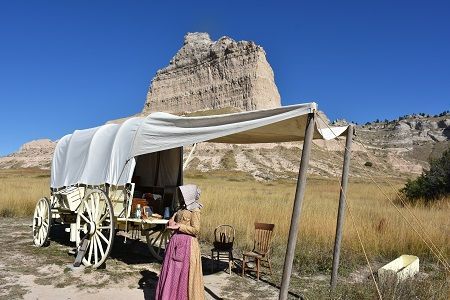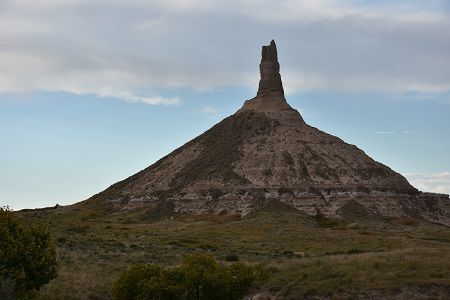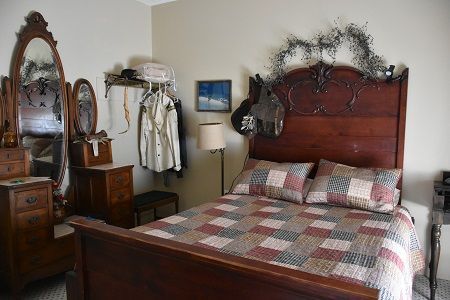Article
Great Road Trips, Part 1: Northwestern Nebraska's Pioneer Trail
Author(s):
So many settlers – 350,000 to 500,000 – made their way through northwestern Nebraska between 1840 and the early 1860s. More than 150 years later, you can still stand in the ruts their footsteps and wagon wheels carved into the grass prairies.
So many settlers — 350,000 to 500,000 – made their way through northwestern Nebraska between 1840 and the early 1860s. More than 150 years later, you can still stand in the ruts their footsteps and wagon wheels carved into the grass prairies. You can see the same landmarks – Chimney Rock and Scotts Bluff – that gave the settlers hope, pointing them in the right direction as they pushed west on the Oregon Trail.

Image Credit: Candyce H. Stapen
Along with history, a drive through northwestern Nebraska gifts you with scenic grass savannahs, buttes, and bluffs. Lodging and restaurants are affordable; the views, expansive; and adventures are available. Hike the hills, go fishing, or bunk at a ranch B&B for a day of horsemanship and wrangler work.
Begin the sightseeing part of your road trip in the Scottsbluff/Gehring area, reached by driving east from Denver, Colorado, or west from Lincoln, Nebraska. Then head to Crawford to explore fossils and Fort Robinson.
- Related: Go on a Fossil Safari in Northwestern Nebraska
The Route West and Chimney Rock National Historic Site
Before it served as the Oregon Trail for wagon trains, the route west started as a network of Indian footpaths. In the 1820s, British, American, and French fur trappers followed the trace to hunt beaver for the lucrative fur trade. As the demand grew, supply wagons made their way from Independence and St. Louis, Missouri, to what became Wyoming and Utah.

Image Credit: Candyce H. Stapen
In the 1840s, although the fur trade diminished because of overhunted beavers, families started to hitch their oxen to wagons to travel west. In 1847, with the publication of the Latter-Day Saints’ Emigrants’ Guide, Mormons took to the trail, heading to Utah. In 1848, the discovery of gold in California spurred more pioneers west, as did the passage of the Donation Land Act in 1850, offering 160-acres of Oregon land to settlers. Unfortunately, that acreage was mostly Native American ancestral land. The Pony Express and stagecoaches followed the trails blazed by the early migrants.
Speaker: Loren Pospisil, site supervisor at Chimney Rock, Nebraska State Historical Society; Video Credit: Candyce H. Stapen
For all those heading west, Chimney Rock, near Bayard, Nebraska, served as a symbol. The sandstone, silt, and ash formation, eroded by wind and storms into a spiral, chimney-like formation, marked the completion of one-third of the route west.
Scotts Bluff National Monument
Like Chimney Rock, Scotts Bluff, further west, served as another important milestone. The Native Americans named the towering formation “Me-a-pa-te,” or “hill that is hard to go around.” Eventually, word got back to the pioneers to look for Scotts Bluff because that route kept them closer to the river for good water, and put them near Marshall Pass, south of the bluff. Taking the pass shortened their journey by eight miles, or almost a day. The wagons rested briefly at Scotts Bluff.
Speaker: Lesley Gaunt, living history interpreter at Nebraska State Historical Society; Video Credit: Candyce H. Stapen
Where to Stay
Monument Inn & Suites, Gehring, offers comfortable rooms with microwaves and mini refrigerators. Even if the furnishings are a bit dated, the rooms are a good-size and the staff is friendly. Rates, including a full breakfast, start from $90 a night.
Barn Anew in Scottsbluff, the town, is a prettily decorated Victorian Bed & Breakfast with seven guest rooms, four of which have private baths. Rates start from $140 per night, including a full breakfast.

Image Credit: Candyce H. Stapen
Our Heritage Guest Ranch, north of Crawford, is a 4,000-acre working cattle ranch. You can rent a simple, but comfortably furnished two-bedroom, one-bath home with a kitchen or stay in the barn room. Because of the country location the ranch uses spring water, which the owners’ say is fine to drink, but be prepared for the water’s high content of sulfur. With advance notice, the owners will add horsemanship and ranch hand experiences. Rates include breakfast. One couple is $55 per night; $165 for the whole house which sleeps 6. Horsemanship and ranch experience extra.




